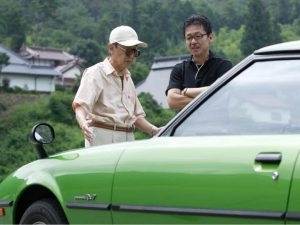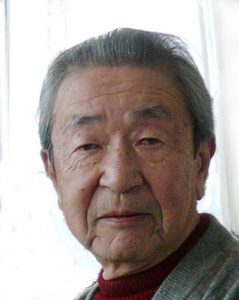Mazda car designer Maeda’s record of A-bomb experience describes memory of searching for family in burned-out ruins, studying in U.S., and suppressing hatred
Aug. 4, 2024
Maeda died in April
by Michio Shimotaka, Staff Writer
Matasaburo Maeda survived the atomic bombing, but his parents and siblings were killed in the event. He later became a pioneer in car design at Toyo Kogyo (now Mazda Motor Corporation). He did not talk much about his A-bomb experience, but before his death in April at the age of 91, he left a record of his experiences such as searching for his family in burned ruins and studying in the United States, the country he once hated.
In 1945, Mr. Maeda lived in Ote-machi (now part of Hiroshima’s Naka Ward) with his father, president of a pharmaceutical company, and four other family members. He was a student of a science course at a junior high school affiliated with Hiroshima Higher Normal School (now Hiroshima University Junior and Senior High School). Among his family members, he was the only one that had evacuated to what is now the city of Shobara in case of air raids. On August 6, injured people fled from Hiroshima, and he heard a rumor that a large bomb had been dropped there.
Intuition tells mother’s death
Mr. Maeda returned to Hiroshima shortly after the war ended and was exposed to residual radiation of the bomb. He saw a city that was completely destroyed. His memoir says: “When I walked out of Hiroshima Station, I could see the Seto Inland Sea as there was nothing around the station. There was an awful smell. I walked south from Gokoku Shrine, but all I saw were collapsed buildings and a charred, swollen body of dead horse was standing.”
His home, which should have been there, was gone. Believing that his family had escaped, he went to his mother Yoshi’s parents’ home in the town of Itsukushima (now part of the city of Hatsukaichi). There, his grandmother hugged him. “At that moment, my intuition told me that my mother was dead.” Yoshi was 43 then.
Her second eldest sister Tomoko, then 15, was at home with her mother and died in the atomic bombing. His eldest sister, Kazuko, who was near the Hiroshima Prefectural Office, and her baby in the womb were killed. His father Tsunejiro had a narrow escape from their home but suffered from illnesses caused by atomic-bomb radiation and died in his 50s in 1952.
At first, Mr. Maeda had grudge against the U.S. for dropping the atomic bomb, thinking, “I will defeat (Harry S.) Truman.” But his feelings changed when he saw cars of the Occupation Forces. “The cars were wonderful. They made me aware of how great America was.” After graduating from college, he joined Toyo Kogyo and went to the U.S. to study in 1964. He brought back the basics of car design and was responsible for the first-generation Savanna RX-7. After retiring, he set up a design company and was involved in the design of Astram Line cars and station buildings.
“I guess my father separated his hatred from his interest in design. He lost everything, but never complained. He was a strong person,” said his eldest son, Ikuo Maeda, 65, with respect. Ikuo also pursued career as a car designer at Mazda.
Concerned about international situation
On the advice of staff of a care facility for A-bomb survivors where Mr. Maeda stayed, he was interviewed by staff of the National Peace Memorial Hall for the Atomic Bomb Victims in Naka Ward, Hiroshima. His memoir was almost completed about three months before his death. “My father had to seal off his memories in order to live, but he must have thought about how much time was left for him to live,” said Ikuo. Mr. Maeda concluded his account by expressing his concern about the international situation. “I want to tell those who are trying to use nuclear weapons, 'Don’t do that.’”
(Originally published on August 4, 2024)









